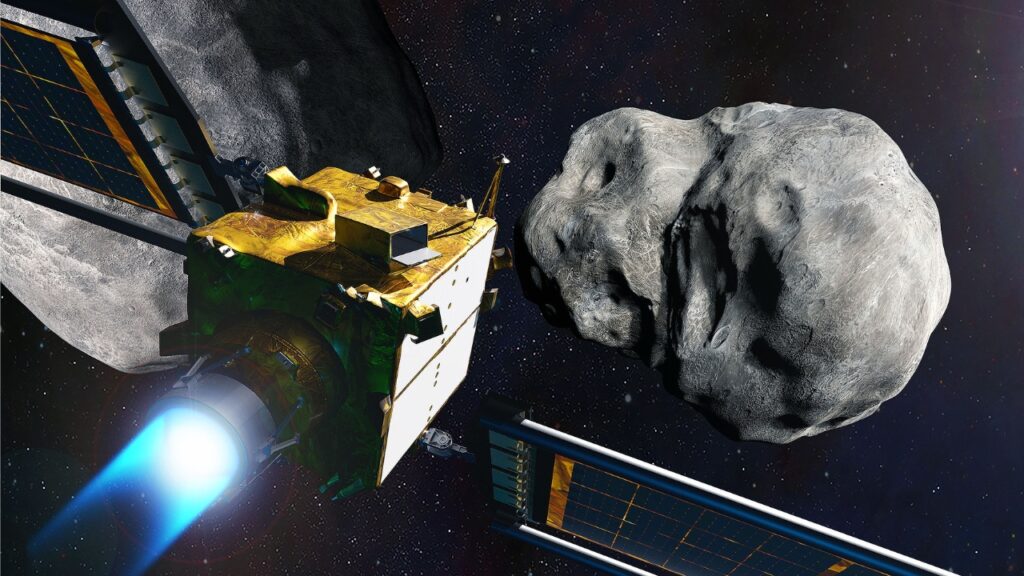NASA’s Double Asteroid Redirection Test (DART) mission successfully demonstrated a planetary defense technique in 2022 by intentionally colliding a spacecraft with the asteroid Dimorphos. This event not only achieved its primary objective of altering the asteroid’s trajectory, but also delivered a surprising bonus – a significant change in Dimorphos’s shape.
From Squashed Ball to Oblong Watermelon: Unveiling Dimorphos’s New Look
Prior to the impact, NASA described Dimorphos as a “roughly symmetrical oblate spheroid,” essentially a squashed ball wider than it is tall. However, following the collision, scientists observed a dramatic transformation. Dimorphos now resembles an “oblong watermelon” or, in technical terms, a “triaxial ellipsoid.” This newfound shape offers valuable clues about the asteroid’s internal composition and challenges our understanding of how such celestial bodies respond to forceful impacts.
The Key Ingredient: A Loosely Packed Composition
The secret behind this unexpected shape change lies in Dimorphos’s internal structure. According to Steve Chesley, a senior research scientist at NASA’s Jet Propulsion Laboratory (JPL) and co-author of a study published in The Planetary Science Journal, Dimorphos is not a solid object, but rather a “loosely packed agglomeration of debris ranging from dust to gravel to boulders.” This loose composition, akin to a giant celestial rubble pile, makes it much easier for the asteroid to deform upon impact compared to a solid, monolithic body like Earth. Studying how such loosely bound objects react to collisions is crucial for improving our understanding of asteroid formation and evolution in the early solar system.
Measuring the Transformation: A Multi-faceted Approach
Scientists employed a combination of three data sources to assess the post-impact state of Dimorphos, effectively piecing together a comprehensive picture of the asteroid’s transformation:
- Ground-based telescope observations: These telescopes tracked the variations in reflected sunlight off the surfaces of both asteroids over time. By meticulously analyzing these subtle changes in light intensity and spectral signatures, researchers could infer the evolving shapes of Didymos and Dimorphos.
- Radio wave data: By bouncing radio waves off the asteroids, researchers obtained valuable information about their shapes. The way radio waves interact with an object’s surface is sensitive to its geometry, allowing scientists to create detailed 3D models of Dimorphos before and after the impact.
- DART’s own imagery: Data captured by DART itself while approaching Dimorphos provided high-resolution close-up views of the asteroid’s surface morphology. These images offered invaluable ground truth data to validate the models generated from other sources.
“We never expected to get this kind of accuracy,” admitted Chesley, highlighting the success of these combined methods. This multi-pronged approach not only revealed the dramatic shape change of Dimorphos but also paves the way for future missions to employ similar techniques for detailed characterization of celestial objects.

Looking Ahead: Unveiling More with Hera
The European Space Agency’s (ESA) Hera mission, scheduled for launch in October 2024, will rendezvous with the Didymos-Dimorphos system in late 2026. Unlike DART, Hera will not collide with either asteroid. Its primary objective is to collect detailed data on the system, including:
- Comparing the actual shape of Dimorphos with the models generated based on DART mission data. This comparison will help validate the accuracy of current models used to predict the effects of impactors on asteroids. Any discrepancies between the models and reality will inform future refinements in our understanding of impact physics and improve the effectiveness of future planetary defense strategies.
- Analyzing any further orbital changes in Dimorphos since the last observations in 2023. The DART mission successfully nudged Dimorphos into a slightly shorter orbit around its larger companion, Didymos. Hera’s high-precision instruments will track Dimorphos’s orbital motion with even greater accuracy, allowing scientists to refine our understanding of the long-term effects of kinetic impactors on celestial bodies.
The combined findings from DART and Hera will provide invaluable insights into the effectiveness of kinetic impactors for planetary defense and the behavior of loosely bound celestial objects under collisional stress. This knowledge will be crucial for refining future planetary defense strategies and ensuring the safety of our planet. While neither Didymos nor Dimorphos posed a threat to Earth, the DART mission serves as a significant accomplishment, showcasing humanity’s growing capability to manipulate the trajectories of celestial objects and potentially safeguard our future from unforeseen cosmic threats. The DART mission is just the first step in this endeavor, paving the way for a more comprehensive understanding of asteroids and the development of robust planetary defense measures.



















